Rick's b.log - 2015/08/30
You are 18.217.4.250, pleased to meet you!
Rick's b.log - 2015/08/30 |
|
| It is the 24th of November 2024 You are 18.217.4.250, pleased to meet you! |
|
mailto: blog -at- heyrick -dot- eu
Hey, guys - ever heard of the "perky goth"? If you have difficulty trying to imagine this, think of Abby Sciuto from NCIS. And maybe instead of further stigmatising a group that I'm sure gets plenty of that already, y'all could conduct a study into why depressed goths are depressed? What do they know that you have missed?
First up - a signal generator for €3. Another piece of school equipment, it claims to output square wave, sine wave, and triangle wave, from 0.05Hz to 200kHz in six overlapping bands. This may be used for providing pulses, or just connecting to a speaker and farting around twiddling the frequency knob for do-it-yourself Doctor Who special effects.
Then two multimeters. A digital one (€3 plus €0,50 for the probes) and an analogue one (€4 with probes thrown in). While there are benefits to a digital multimeter, I somehow find analogue ones more reassuring. My first multimeter was a big ol' swing-needle meter from Maplin, back in the late eighties.
The digital meter is simple to use; selection buttons on the side and a clear legend along with a big bold readout plus a beeper for continuity tests. It is quite nice actually.
I also picked up some cables.
Now for some fun!
Here's a sine wave at around 50kHz:
Square wave? That ought to be easy, right? No messing with fancy waveforms, just on and off. Right? Right?
Clock this:
For lulz, here's the square (!) wave at 100kHz:
I had, earlier, opened up the signal generator to check that nothing was loose. Here are the simple looking insides:
The non-working selector passes into these capacitors. From the right, the capacitors are 6n8, 68n, and 680n. These two are 4k7 and 2k2 which equals 6k9 - what is that? 6.9µF? If so, I would imagine the remaining two on the left are 68µF and 680µF.
Newsflash! Goths are depressed!
A recent study (described here in The Guardian) says that teenage goths are are three times more likely to be clinically depressed blah de blah. In other news, the Pope is Catholic and all men are paedos.
More electronics stuff from a vide grenier!
This time last year I purchased an oscilloscope. This time this year, I met the same person and I was prepared with some cash taken out of the bank in advance.

The meter is not calibrated. You just select a range and twiddle the knob. More worryingly, the behaviour of the amplitude knob is backwards to the legend - full left is quietest. I'd better make a note of that!

The analogue meter? More complicated. In the time it took to take this picture, the new AAA cell was heated to around 65°C. That doesn't sound right! I am missing a strange little 15V battery, so maybe without that the meter acts weird? I'll look in the supermarket tomorrow and if I can't find out (and I don't expect to see anything that specialised), I can get one from Amazon. If not, well, the circuit looks fairly simple...
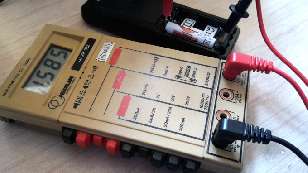
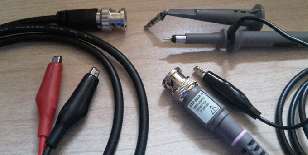
On the right, finally a proper attenuated probe for the oscilloscope. The probe has a ×1 and ×10 switch on the side (to divide large signals by ten so they don't overload the oscilloscope). There is a detachable ground clip (the black wire to the croc clip), and as can be seen from the photo, I can either have a fine-tipped probe to poke around with, or a cap that fits over the end with a hook to attach to the leg of a component - you can see it in the photo hooked to the end of a dead 3.5mm audio plug. Very nice. I also have a tiny screwdriver (there is a potentiometer in the bayonet lug for tuning the frequency response), as well as three coloured rings to identify the probe. Black, light blue, and the pink that was fitted by default. This discusses tuning test probes, though I only have one adjustment as modern probes have a laser etched (pre-tuned) circuit in the probe head. For €2, it is quite nice to have something so much better than two wires ending in banana plugs!
As an additional bonus, the cable for the signal generator is croc clips to a BNC, so it can be used for the second channel of the oscilloscope.

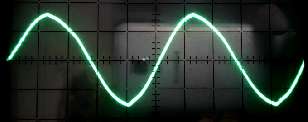
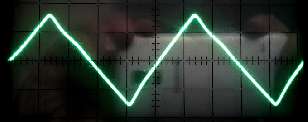
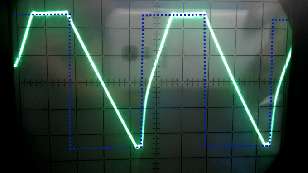
Your challenge, dear reader, is to tell me at what frequency this is. This will help you:
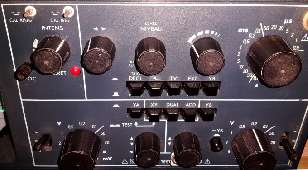
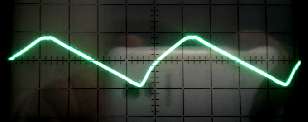
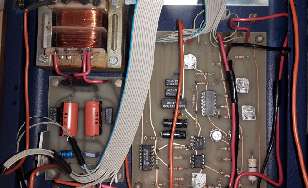
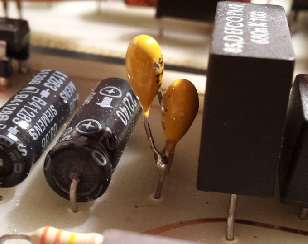
David Pilling, 16th September 2015, 13:53
What to say, if the 'scope was better you'd see how bad the output of the signal generator is...
David Pilling, 16th September 2015, 14:34 Rick, 16th September 2015, 15:30 David Pilling, 16th September 2015, 16:33
The AD9850 is today's equivalent.
Anyway a useful tool, as is the 'scope.
David Pilling, 16th September 2015, 17:27 Rick, 17th September 2015, 14:30
| © 2015 Rick Murray |
This web page is licenced for your personal, private, non-commercial use only. No automated processing by advertising systems is permitted. RIPA notice: No consent is given for interception of page transmission. |